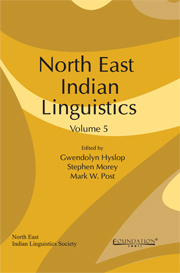Book contents
- Frontmatter
- Contents
- About the Contributors
- Foreword
- A Note from the Editors
- Contact and genetic linguistics
- Historical-comparative Tibeto-Burman grammar
- The North East Indian noun phrase
- Assamese grammar
- 9 Reciprocal constructions in Asamiya
- 10 Question formation in Asamiya (Assamese)
- Advances in Boro-Garo phonology
- Poetics and text
10 - Question formation in Asamiya (Assamese)
from Assamese grammar
Published online by Cambridge University Press: 05 September 2013
- Frontmatter
- Contents
- About the Contributors
- Foreword
- A Note from the Editors
- Contact and genetic linguistics
- Historical-comparative Tibeto-Burman grammar
- The North East Indian noun phrase
- Assamese grammar
- 9 Reciprocal constructions in Asamiya
- 10 Question formation in Asamiya (Assamese)
- Advances in Boro-Garo phonology
- Poetics and text
Summary
Introduction
Languages use some grammatical devices for specifying that a particular utterance is to be understood, not as an assertion, but as a request for information, known as interrogation or question formation. In written text a question mark may be used to denote an interrogative structure, but in spoken form punctuation cannot be used and it is stress patterns or some grammatical system or context that may give a clue to an utterance being interrogative. Questioning represents one of the unique characteristics of the human mind and the ways of forming questions vary from language to language which need to be explored from the linguistic point of view. This paper investigates various ways of forming questions in Asamiya (Assamese).
In a majority of the languages questions can be broadly classified into two major groups according to the type of answer anticipated (Huddleston and Pullum 2002: 161, 168). These are: a) general questions (also known as closed or polar), and b) special questions (also known as open, content or wh-questions in English). In section 2 of this paper various subcategories of general questions are examined. Section 3 contains the discussion on special questions.
General questions
Typologically, general questions include ‘yes/no’ questions and ‘alternative’ questions.
Yes/no questions
Yes/no questions, one of the subcategories of general questions in Asamiya, is formed by suffixation of a question clitic (QC) -ne to the finite verb or by the insertion of a question particle (QP) neki after it.
- Type
- Chapter
- Information
- North East Indian Linguistics , pp. 234 - 246Publisher: Foundation BooksPrint publication year: 2013



